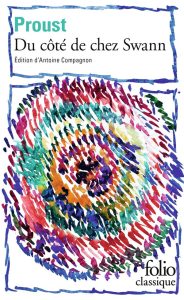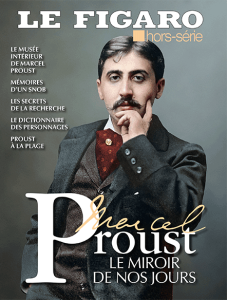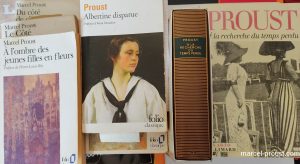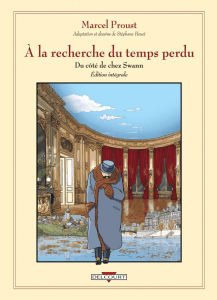Learning through Proust ricochets off all the other pleasures of life. The story of the greatest French-speaking writer of the 20th century begins with Impressionism and ends with the triumph of jazz. Between the two, the freluquet Marcel has become the great Proust.
More than any other great writer, Proust has disappeared under the weight of his myth. His career was that of a child of a bourgeois family; first student at Condorcet, then at Sciences-po before becoming a young poet who, throughout his life, will send more letters than he will ever have received. But what about the socialite… The living room snob… The asthmatic… The meticulous author… The one everyone claims (falsely) to have read without really knowing him?
A work that escapes history and structures
From Proust we retain above all a literary style saturated with endless expanses. Long sentences… long paragraphs making up endless chapters… and, of course, a story presumptuously titled In Search of Lost Time. His younger brother, Robert, used a touch of humor about this: The unfortunate thing is that people have to be very sick or break a leg to have time to read. The research. In his marvelous essay, How Proust can change your life the philosopher Alain de Botton illustrates the point thus: the readers find themselves confronted […] to serpentine sentences, the largest of which, found in the fifth volume, would span nearly four meters in normal type size, and wrap seventeen times around the base of a wine bottle. (sic)
This special issue of Figaro proceeds like Alain de Botton. It offers a singular appreciation of Proust’s work. Through a summary in four parts: The inner museum… The works and the days… The time regained… The intermittences of the heart… we understand that In Search of Lost Time escapes the history of literature and its traditional structures. The various articles explain in an accessible, and sometimes semi-serious way, how the most famous literary work of the XXth century stems from a closeness between its author and its readers, so that any previous production appears summary and imprecise, even thick and cumbersome. Yes ! This Special Edition provides access to the intellectual and creative universe of the one everyone likes to brag about: “I should reread Proust”, without having ever read it, except in high school. , some passages subject to boring text explanations.
” Life is too short and Proust is too long. »
Anatole France
 You have to imagine Marcel Proust born in 1871, when France was partly occupied by the Prussian invaders. The writing of The research begins in 1907, a titanic work which will lead its author until his death in 1922; fifteen years of daily work to get rid of appearances and other useless ambitions, his mind diverted from everything that is not his work, Proust devoted to it his last strength. Although the novel is long, it nevertheless exudes a strange transience. Just do we have the feeling of having penetrated there that Recovered time already carries us away. It is in this that the essential truth transmitted by the narrator takes shape, evoking the absurdity of existence as it escapes us.
You have to imagine Marcel Proust born in 1871, when France was partly occupied by the Prussian invaders. The writing of The research begins in 1907, a titanic work which will lead its author until his death in 1922; fifteen years of daily work to get rid of appearances and other useless ambitions, his mind diverted from everything that is not his work, Proust devoted to it his last strength. Although the novel is long, it nevertheless exudes a strange transience. Just do we have the feeling of having penetrated there that Recovered time already carries us away. It is in this that the essential truth transmitted by the narrator takes shape, evoking the absurdity of existence as it escapes us.
In Search of Lost Time is written according to a linear frame over which several parallel stories intersect and propagate in concentric waves around the main characters and a hundred secondary figures. Thus, the reader is invited to discover human multiplicity. Apart from the narrator’s mother and grandmother, both radiant with perfection and love, there is only a multiplicity of protagonists in whom indifference, malignity, the fleeting and the ephemeral prevail. The only chronological markers are the dates of an era rich in important events: the beginning of the IIIth Republic… the Dreyfus affair… the 1914-1918 war…
The art and culture of loving Proust
 One of the most marvelous articles of this Special Edition is the one entitled The indoor museum ; it opens the doors of a Proustian art gallery, proving to be a masterly treatise on the history of art. From Botticelli’s young girls to Nicolas Poussin’s sweet clouds, from Giotto’s processions to Rembrandt’s chiaroscuro, The research is a gallery where you can admire the most fabulous collection of masterpieces. It reveals that Proust had only one religion, that of art. It all starts with a description taken from On the Swann side, when the narrator evokes the now famous magic lantern that distracts him in his room in Combray during his long evenings of boredom? ” […] ; and, to Like the first architects and master glassmakers of the Gothic age, she replaced the opacity of the walls with impalpable iridescences, supernatural multicolored apparitions, where legends were depicted as in a flickering and momentary stained glass window.. »
One of the most marvelous articles of this Special Edition is the one entitled The indoor museum ; it opens the doors of a Proustian art gallery, proving to be a masterly treatise on the history of art. From Botticelli’s young girls to Nicolas Poussin’s sweet clouds, from Giotto’s processions to Rembrandt’s chiaroscuro, The research is a gallery where you can admire the most fabulous collection of masterpieces. It reveals that Proust had only one religion, that of art. It all starts with a description taken from On the Swann side, when the narrator evokes the now famous magic lantern that distracts him in his room in Combray during his long evenings of boredom? ” […] ; and, to Like the first architects and master glassmakers of the Gothic age, she replaced the opacity of the walls with impalpable iridescences, supernatural multicolored apparitions, where legends were depicted as in a flickering and momentary stained glass window.. »
Throughout the chapters, various paintings and frescoes appear. Here, the description of Bloch and his circumflex eyebrows resembles the portrait of Sultan Mehmet II attributed to Giovanni Bellini… Further on, the appalling nose of M. de Palancy features the features of a Ghirlandajo… “ Swann had always had this particular taste for liking to find in the painting of the masters not only the general characteristics of the reality that surrounds us, but what seems on the contrary the least susceptible to generality, the individual features of the faces that we know : […] “Further still, The surrender of Breda, famous painting by Velázquez, is used in a diatribe by Baron de Charlus… As for the death of Bergotte, spiritual father of the narrator, it takes place in the fifth volume, The Prisoner, after observing a painting by Vermeer exhibited today in The Hague: View of Delft…
A fictional society inspired by reality
 If Marcel Proust wonderfully depicted his environment, it was because he lived outside, belonging to the patrician society of the 19th century salons.th century, without taking part in it, except with the circumspection of a squirrel. For him, the 14-18 war was nothing but a subject of conversation. ” Political truth, when one approaches informed men and believes one has reached it, slips away. “, he writes in The side of Guermantes. In other words, there is no political truth in Proust, preferring to draw inspiration from the circles and salons in which he will collect the models, the anecdotes, the vocabulary and the decorations of the fictitious society to which he gave life ; …
If Marcel Proust wonderfully depicted his environment, it was because he lived outside, belonging to the patrician society of the 19th century salons.th century, without taking part in it, except with the circumspection of a squirrel. For him, the 14-18 war was nothing but a subject of conversation. ” Political truth, when one approaches informed men and believes one has reached it, slips away. “, he writes in The side of Guermantes. In other words, there is no political truth in Proust, preferring to draw inspiration from the circles and salons in which he will collect the models, the anecdotes, the vocabulary and the decorations of the fictitious society to which he gave life ; …
…; an imaginary story from which one can assume that everything in it really happened; the characters of his story really existed, by reconstructing it it is possible to discover the importance of the tiny in a playground located between the Belle Époque (1870-1914) and the Roaring Twenties (1918-1929). The reissue of this Special Edition of Figaro – already published in 2013 – increased and improved, allows us to rediscover the one who, futilely, lingered on a detail of toilet and a physical particularity… the one who, concierge, reported many anecdotes, situations and jokes… the one who, indiscreet, was the chronicler of his time by giving Le Figaro a series of his famous “Parisian Salons” published in the form of tickets between 1903 and 1904, prefiguring his now famous Research. The circle is complete.
Jérôme ENEZ-VRIAD
© October 2022 – Bretagne Actuelle & JE-V.
Marcel Proust: The Mirror Today – A special issue of Le Figaro – Sale in kiosk, aubette, at tobacconists and on the Figaro site shop – 207 glossy-color pages – €8.90
Partial documentation:
In addition to Le Figaro Hors-série mentioned above, let us note Proust’s ABCdaire by Thierry Laget – at Flammarion /-/ How Proust can change your life by Alain de Botton – Editions 10/18 /-/ Proust (volume I & II) by Jean Yves Tadié – Folio Editions /-/Proust’s coat by Lorenza Foschini – Quai Voltaire Editions /-/ Marcel Proust by Edmund White – Fides Editions /-/Proust’s Love Dictionary by Jean-Paul & Raphaël Enthoven – Editions Plon /-/ In Search of Lost Timecomplete edition mcmlxxxix at Jean de Bonnot /-/In Search of Lost Timecomic book in eight volumes, current series by Stéphane Heuet at Delcourt /-/In Search of Lost Time, TV movie directed by Nina Companeez /-/The books of my life: Simone Signoret (see at 7.15 minutes) – INA
Marcel Proust: The mirror nowadays, a special issue of Le Figaro

